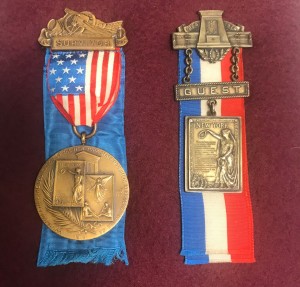The Confederate prison camp at Andersonville, Georgia, also known as Camp Sumter, was designed to hold a maximum of 10,000 Union prisoners. At its peak, it held more than three times that number under horrific conditions. During its 14 months of existence, Andersonville Prison held more than 45,000 Union soldiers, of whom 12,920 died, mostly of starvation and disease.[1]
On 29 April 1914, nearly 50 years after the prison’s liberation, survivors from New York State assembled on the grounds of the original prison to dedicate a monument to the roughly-2500 of their fellow soldiers from that State who had been imprisoned there.
The 144 aging veterans who made the trip were awarded this medal (left) by the State. They were made by Whitehead & Hoag Company of New York City and are engraved on the reverse: “Presented to (soldier’s name) by the State of New York in Recognition of his Heroism, Sacrifice, and Patriotism.” (The engraving on the one in this photo does not include a soldier’s name.) As you might guess, very few of these medals still exist, especially in this pristine condition.
The second medal – or badge – was issued to the guests of the Andersonville Monument Dedication Commission at that monument dedication. This badge is even more rare. In fact, I’ve never before seen one intact, much less in near-mint condition. It was made by J. F. Neuman in New York City.
As mentioned in this post, 5369 Union soldiers were reported “missing or captured” at the Battle of Gettysburg and at least 303 were incarcerated at Andersonville. 107 of them served in a New York regiment but only two lived until 1914 and attended the monument dedication there.[2] They were:
- – Private John Sears, Co. F, 119th New York Inf.
- – Private Robert J. Woodward, Co. C, 154th New York Inf.
The Guest badge is something of a mystery. Its design and manufacture is mentioned in the Commission Report but, unlike the veteran badge, there is no depiction of it there. And, while the report describes the ceremony in which veterans were awarded their medals, there’s conspicuously no mention of when or under what conditions the Guest badges were distributed.
The report says, “The veterans having been assembled in military order within the prison stockade, the services of decorating them with the medals now occurred.” The Chairman of the Commission is then quoted as saying, “Each comrade, when his name is called, will march to the front and receive his medal.”
This panoramic photograph in the report depicts the “Line Up at Andersonville for Presentation of New York State’s Commemorative Dedication Medal.” That photograph does not appear to include the wives and daughters of the veterans who were among the guests. In the reception line at the center of the photograph are the Commissioners, the few female presenters, and a handful of other guests. Some of them are wearing one type of badge or another but most are not. So the timing of the distribution of the Guest badges remains a mystery.
So how many of these medals were made? According to the New York State Archives, no invoices or other records of the manufacture or engraving of the medals still exist. So we’ll have to make some guesstimates.
The Commission originally identified about 400 former New York soldiers who had survived Andersonville and were still living in the State at that time. They were all were invited to attend the ceremonies at Andersonville at the Commission’s expense. Each veteran was responsible for getting himself to New York City, however, where a special train would take them to and from Andersonville. The veterans were also permitted to bring family and friends at their own expense, estimated by the Commission as $60 per person.
Of the 400 or so veterans that were invited, 248 expressed an intention to go. As the date approached, however, that number twindled regularly due to the illness or death of some of the veterans. By the time that the train left Pennsylvania Station, the passengers numbered just 222, according to the Commission’s report[3], including veterans and guests. The latter group consisted of twelve Commission members (half of whom were veterans), two clerks, a stenographer, a nurse, a photographer, a few politicians and dignitaries, and “a goodly number” of wives and children. (But the final published list of attendees included 144 veterans and 79 guests for a total of 223.)
Contemporary newspaper accounts vary, however. One newspaper reported that there were “262 in the party”[4] and another said that there were “162 survivors”[5] in the group. These seem oddly specific, given that they conflict with the official report.
One veteran, Jacob D. Perkins, Private, 85th New York Infantry, reported that he received an engraved medal in the mail even though he did not attend the ceremony at Andersonville. This suggests that he was among those who originally expressed an intention to go to the dedication but later bowed out.[6]
The Survivors medals would presumably have been ordered as soon as the original list of recipients was compiled (248), would have included a few extras, but would certainly not have exceeded the total number of eligible veterans (400). So I estimate that between 300 and 400 were manufactured, with at least 248 being inscribed with the name and regiment of a specific veteran.
The order for the Guest medals would have been placed at the same time. In the end, 79 guests attended the ceremony but there is no record of how many had originally expressed an interest to go. That number is unlikely to be more than 105, however, accounting for a spouse for each veteran who had bowed out. So even accounting for spares, it is unlikely that more than 150 of the Guest medals were manufactured.
Sources:
[1] Andersonville National Historic Site, https://www.nps.gov/ande/index.htm
[2] Kevin Frye, Andersonville Historian; Andersonville Facebook Page or at andersonvillehistorian@gmail.com.
[3] “A Pilgrimage To The Shrines of Patriotism: The Report of the Commission to Dedicate the Monument Erected by the State of New York in Andersonville, Georgia” (Albany, NY: State of New York & Andersonville Monument Dedication Commission, Printer: J. B. Lyon Company, 1916)
[4] Col. Samuel C. Pierce, Commander, Dept, of N. Y., G. A. R., Rochester, N. Y. in The Buffalo Enquirer, 11 May 1914.
[5] The Brooklyn Daily Eagle (Brooklyn, NY), 10 May 1914.
[6] Star Gazette (Elmira, NY), 28 Jul 1914



